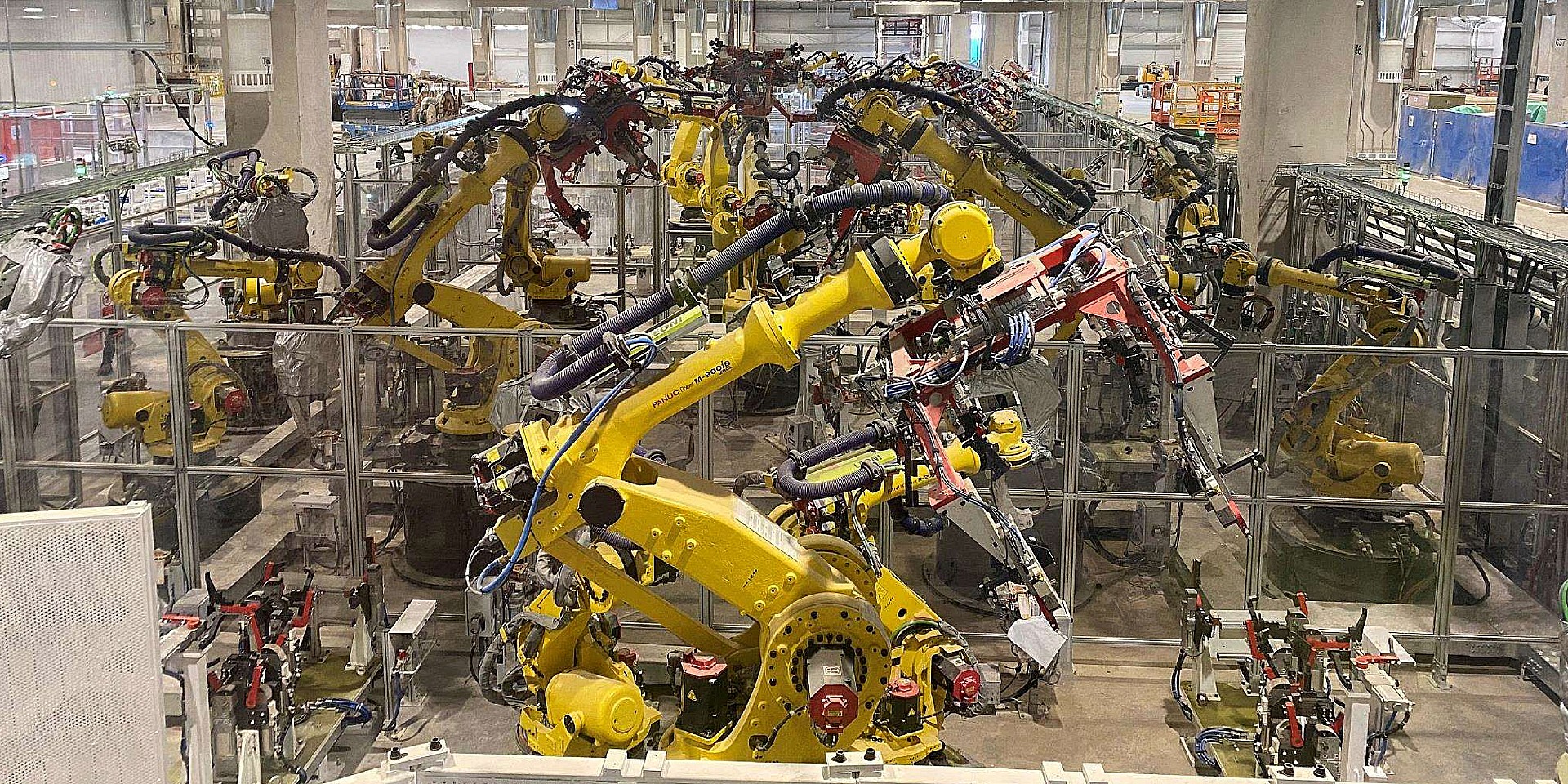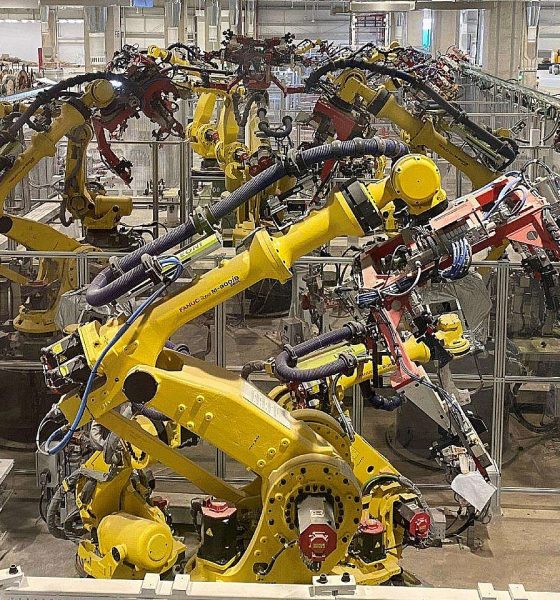Tesla’s Q3 Update Letter revealed that the electric automaker is trending toward a possible manufacturing rate of 1 million vehicles a year after a 25% increase in Quarter-over-Quarter Model 3 and Model Y production at the Fremont facility was listed in the document. Between Fremont and Giga Shanghai, Tesla is currently operating with an annual production rate of 840,000 cars a year.
Tesla’s production of both the Model 3 sedan and Model Y crossover increased from 400,000 to 500,000 vehicles annually from Q2 to Q3. The two update letters, which detail the company’s progress during two separate three-month spans, indicate manufacturing efficiency and newly installed production lines.
The company wrote:
“We have recently increased capacity of Model 3 / Model Y to 500,000 units a year. In order to do this, we restarted our second paint shop, installed the largest diecasting machine in the world, and upgraded our Model Y general assembly line. Production should reach full capacity toward the end of this year or beginning of next year.”
Tesla (TSLA) crushes Q3 earnings with record profit, accelerates global growth
The increase in production is expected, as Tesla expanded its Model Y production line at the Fremont plant in mid-July. The company filed several applications on the City’s Public Access website, which detailed planned advancements of “General Assembly 4.5,” which is designated for Tesla’s newest vehicle’s manufacturing processes.
Additionally, the installation of two die-cast machines allowed for the Model Y’s single-piece casting design, which increased safety and manufacturing efficiency.
Tesla readies Model Y Giga Press for next-level production efficiency
But the global push toward electrification for Tesla goes far beyond Northern California. In China, the company’s Giga Shanghai facility has a production capacity of 250,000 Model 3 units a year. The company detailed its advancements at the plant in the Q3 Update Letter:
“Model 3 production capacity has increased to 250,000 units a year. We reduced the price of Model 3 to 249,900 RMB after incentives, making it the lowest-price premium mid-sized sedan in China. This was enabled both by lower-cost batteries and an increased level of local procurement. As a result of this shift in cost and starting price, we recently added a third production shift to our Model 3 factory. “
Currently, the Model 3 is the only Tesla vehicle produced at the facility. However, the company plans to begin building the Model Y at Giga Shanghai by the end of 2020.
With Fremont and Shanghai producing 590,000 and 250,000 vehicles annually, Tesla is on track to reach a manufacturing rate of 1 million vehicles per year. It is possible that with Giga Shanghai’s introduction of the Model Y, the two plants could reach the million vehicle threshold together. However, Tesla has plans for two other factories that will contribute to an ever-growing annual production rate.
In Germany, Giga Berlin is quickly taking shape, and Tesla plans to begin production at this facility in 2021. The company also detailed the progress at its first European plant by saying:
“Construction of the Gigafactory in Berlin continues to progress rapidly. Buildings are under construction, and equipment move-in will start over the coming weeks. At the same time, the Giga Berlin team continues to grow. Production is expected to start in 2021.”
Finally, Tesla is also working on building another U.S.-based plant in Austin, Texas, which will introduce the Cybertruck and Semi, and also produce the Model 3 and Model Y for East Coast customers.
Tesla reported its fifth-consecutive profitable quarter, announcing revenue of $8.771 billion for the quarter, and non-GAAP earnings per share of $0.76. Additionally, Tesla posted $809M GAAP operating income, resulting in a 9.2% operating margin. The company also ended the third quarter with $331M GAAP net income and $874M non-GAAP net income (ex-SBC).

Elon Musk
Elon Musk and Tesla AI Director share insights after empty driver seat Robotaxi rides
The executives’ unoccupied tests hint at the rapid progress of Tesla’s unsupervised Robotaxi efforts.

Tesla CEO Elon Musk and AI Director Ashok Elluswamy celebrated Christmas Eve by sharing personal experiences with Robotaxi vehicles that had no safety monitor or occupant in the driver’s seat. Musk described the system’s “perfect driving” around Austin, while Elluswamy posted video from the back seat, calling it “an amazing experience.”
The executives’ unoccupied tests hint at the rapid progress of Tesla’s unsupervised Robotaxi efforts.
Elon and Ashok’s firsthand Robotaxi insights
Prior to Musk and the Tesla AI Director’s posts, sightings of unmanned Teslas navigating public roads were widely shared on social media. One such vehicle was spotted in Austin, Texas, which Elon Musk acknowleged by stating that “Testing is underway with no occupants in the car.”
Based on his Christmas Eve post, Musk seemed to have tested an unmanned Tesla himself. “A Tesla with no safety monitor in the car and me sitting in the passenger seat took me all around Austin on Sunday with perfect driving,” Musk wrote in his post.
Elluswamy responded with a 2-minute video showing himself in the rear of an unmanned Tesla. The video featured the vehicle’s empty front seats, as well as its smooth handling through real-world traffic. He captioned his video with the words, “It’s an amazing experience!”
Towards Unsupervised operations
During an xAI Hackathon earlier this month, Elon Musk mentioned that Tesla owed be removing Safety Monitors from its Robotaxis in Austin in just three weeks. “Unsupervised is pretty much solved at this point. So there will be Tesla Robotaxis operating in Austin with no one in them. Not even anyone in the passenger seat in about three weeks,” he said. Musk echoed similar estimates at the 2025 Annual Shareholder Meeting and the Q3 2025 earnings call.
Considering the insights that were posted Musk and Elluswamy, it does appear that Tesla is working hard towards operating its Robotaxis with no safety monitors. This is quite impressive considering that the service was launched just earlier this year.
Elon Musk
Starlink passes 9 million active customers just weeks after hitting 8 million
The milestone highlights the accelerating growth of Starlink, which has now been adding over 20,000 new users per day.

SpaceX’s Starlink satellite internet service has continued its rapid global expansion, surpassing 9 million active customers just weeks after crossing the 8 million mark.
The milestone highlights the accelerating growth of Starlink, which has now been adding over 20,000 new users per day.
9 million customers
In a post on X, SpaceX stated that Starlink now serves over 9 million active users across 155 countries, territories, and markets. The company reached 8 million customers in early November, meaning it added roughly 1 million subscribers in under seven weeks, or about 21,275 new users on average per day.
“Starlink is connecting more than 9M active customers with high-speed internet across 155 countries, territories, and many other markets,” Starlink wrote in a post on its official X account. SpaceX President Gwynne Shotwell also celebrated the milestone on X. “A huge thank you to all of our customers and congrats to the Starlink team for such an incredible product,” she wrote.
That growth rate reflects both rising demand for broadband in underserved regions and Starlink’s expanding satellite constellation, which now includes more than 9,000 low-Earth-orbit satellites designed to deliver high-speed, low-latency internet worldwide.
Starlink’s momentum
Starlink’s momentum has been building up. SpaceX reported 4.6 million Starlink customers in December 2024, followed by 7 million by August 2025, and 8 million customers in November. Independent data also suggests Starlink usage is rising sharply, with Cloudflare reporting that global web traffic from Starlink users more than doubled in 2025, as noted in an Insider report.
Starlink’s momentum is increasingly tied to SpaceX’s broader financial outlook. Elon Musk has said the satellite network is “by far” the company’s largest revenue driver, and reports suggest SpaceX may be positioning itself for an initial public offering as soon as next year, with valuations estimated as high as $1.5 trillion. Musk has also suggested in the past that Starlink could have its own IPO in the future.
News
NVIDIA Director of Robotics: Tesla FSD v14 is the first AI to pass the “Physical Turing Test”
After testing FSD v14, Fan stated that his experience with FSD felt magical at first, but it soon started to feel like a routine.

NVIDIA Director of Robotics Jim Fan has praised Tesla’s Full Self-Driving (Supervised) v14 as the first AI to pass what he described as a “Physical Turing Test.”
After testing FSD v14, Fan stated that his experience with FSD felt magical at first, but it soon started to feel like a routine. And just like smartphones today, removing it now would “actively hurt.”
Jim Fan’s hands-on FSD v14 impressions
Fan, a leading researcher in embodied AI who is currently solving Physical AI at NVIDIA and spearheading the company’s Project GR00T initiative, noted that he actually was late to the Tesla game. He was, however, one of the first to try out FSD v14.
“I was very late to own a Tesla but among the earliest to try out FSD v14. It’s perhaps the first time I experience an AI that passes the Physical Turing Test: after a long day at work, you press a button, lay back, and couldn’t tell if a neural net or a human drove you home,” Fan wrote in a post on X.
Fan added: “Despite knowing exactly how robot learning works, I still find it magical watching the steering wheel turn by itself. First it feels surreal, next it becomes routine. Then, like the smartphone, taking it away actively hurts. This is how humanity gets rewired and glued to god-like technologies.”
The Physical Turing Test
The original Turing Test was conceived by Alan Turing in 1950, and it was aimed at determining if a machine could exhibit behavior that is equivalent to or indistinguishable from a human. By focusing on text-based conversations, the original Turing Test set a high bar for natural language processing and machine learning.
This test has been passed by today’s large language models. However, the capability to converse in a humanlike manner is a completely different challenge from performing real-world problem-solving or physical interactions. Thus, Fan introduced the Physical Turing Test, which challenges AI systems to demonstrate intelligence through physical actions.
Based on Fan’s comments, Tesla has demonstrated these intelligent physical actions with FSD v14. Elon Musk agreed with the NVIDIA executive, stating in a post on X that with FSD v14, “you can sense the sentience maturing.” Musk also praised Tesla AI, calling it the best “real-world AI” today.










